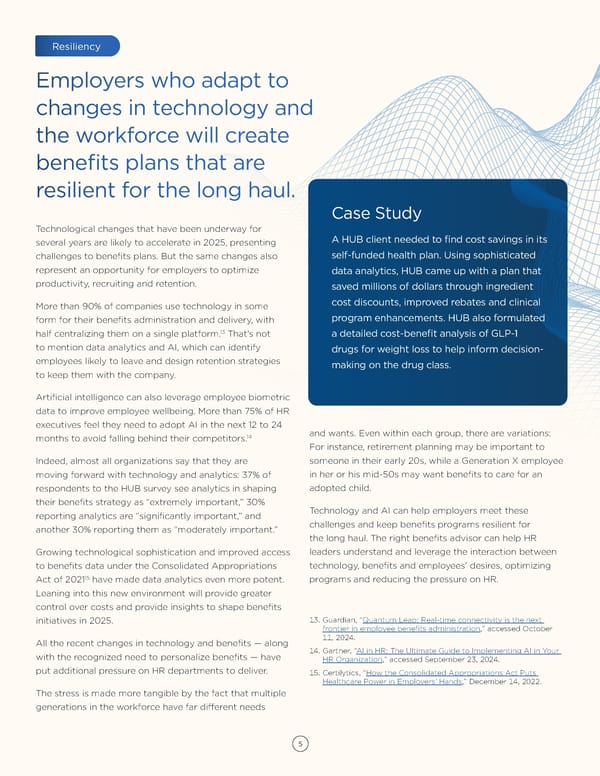Resiliency Employers who adapt to changes in technology and the workforce will create benefits plans that are resilient for the long haul. Case Study Technological changes that have been underway for several years are likely to accelerate in 2025, presenting A HUB client needed to find cost savings in its challenges to benefits plans. But the same changes also self-funded health plan. Using sophisticated represent an opportunity for employers to optimize data analytics, HUB came up with a plan that productivity, recruiting and retention. saved millions of dollars through ingredient More than 90% of companies use technology in some cost discounts, improved rebates and clinical form for their benefits administration and delivery, with program enhancements. HUB also formulated 13 That’s not half centralizing them on a single platform. a detailed cost-benefit analysis of GLP-1 to mention data analytics and AI, which can identify drugs for weight loss to help inform decision- employees likely to leave and design retention strategies making on the drug class. to keep them with the company. Artificial intelligence can also leverage employee biometric data to improve employee wellbeing. More than 75% of HR executives feel they need to adopt AI in the next 12 to 24 14 and wants. Even within each group, there are variations: months to avoid falling behind their competitors. For instance, retirement planning may be important to Indeed, almost all organizations say that they are someone in their early 20s, while a Generation X employee moving forward with technology and analytics: 37% of in her or his mid-50s may want benefits to care for an respondents to the HUB survey see analytics in shaping adopted child. their benefits strategy as “extremely important,” 30% reporting analytics are “significantly important,” and Technology and AI can help employers meet these another 30% reporting them as “moderately important.” challenges and keep benefits programs resilient for the long haul. The right benefits advisor can help HR Growing technological sophistication and improved access leaders understand and leverage the interaction between to benefits data under the Consolidated Appropriations technology, benefits and employees’ desires, optimizing 15 programs and reducing the pressure on HR. Act of 2021 have made data analytics even more potent. Leaning into this new environment will provide greater control over costs and provide insights to shape benefits initiatives in 2025. 13. Guardian, “Quantum Leap: Real-time connectivity is the next frontier in employee benefits administration,” accessed October All the recent changes in technology and benefits — along 11, 2024. with the recognized need to personalize benefits — have 14. Gartner, “AI in HR: The Ultimate Guide to Implementing AI in Your HR Organization,” accessed September 23, 2024. put additional pressure on HR departments to deliver. 15. Certilytics, “How the Consolidated Appropriations Act Puts Healthcare Power in Employers’ Hands,” December 14, 2022. The stress is made more tangible by the fact that multiple generations in the workforce have far different needs 5
 The Future of Employee Benefits: Strategies for 2025 Page 4 Page 6
The Future of Employee Benefits: Strategies for 2025 Page 4 Page 6